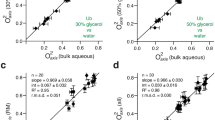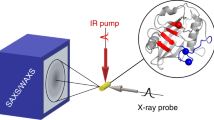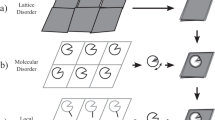Abstract
Internal motion is central to protein folding1, to protein stability through the resulting residual entropy2, and to protein function1,3,4,5,6,7. Despite its importance, the precise nature of the internal motions of protein macromolecules remains a mystery. Here we report a survey of the temperature dependence of the fast dynamics of methyl-bearing side chains in a calmodulin–peptide complex using site-specific deuterium NMR relaxation methods. The amplitudes of motion had a markedly heterogeneous spectrum and segregated into three largely distinct classes. Other proteins studied at single temperatures tend to segregate similarly. Furthermore, a large variability in the degree of thermal activation of the dynamics in the calmodulin complex indicates a heterogeneous distribution of residual entropy and hence reveals the microscopic origins of heat capacity in proteins. These observations also point to an unexpected explanation for the low-temperature ‘glass transition’ of proteins. It is this transition that has been ascribed to the creation of protein motional modes that are responsible for biological activity5,6,7.
This is a preview of subscription content, access via your institution
Access options
Subscribe to this journal
Receive 51 print issues and online access
$199.00 per year
only $3.90 per issue
Buy this article
- Purchase on Springer Link
- Instant access to full article PDF
Prices may be subject to local taxes which are calculated during checkout




Similar content being viewed by others
References
Frauenfelder, H., Sligar, S. G. & Wolynes, P. G. The energy landscape and motions of proteins. Science 254, 1598–1603 (1991).
Karplus, M., Ichiye, T. & Pettitt, B. M. Configurational entropy of native proteins. Biophys. J. 52, 1083–1088 (1987).
Frauenfelder, H. & Wolynes, P. G. Rate theories and puzzles of hemeprotein kinetics. Science 229, 337–345 (1985).
Austin, R. H., Beeson, K. W., Eisenstein, L., Frauenfelder, H. & Gunsalus, I. C. Dynamics of ligand binding to myoglobin. Biochemistry 14, 5355–5373 (1975).
Rasmussen, B. F., Stock, A. M., Ringe, D. & Petsko, G. A. Crystalline ribonuclease A loses function below the dynamical transition at 220K. Nature 357, 423–424 (1992).
Zavodszky, P., Kardos, J., Svingor, A. & Petsko, G. A. Adjustment of conformational flexibility is a key event in the thermal adaptation of proteins. Proc. Natl Acad. Sci. USA 95, 7406–7411 (1998).
Feher, V. A. & Cavanagh, J. Millisecond-timescale motions contribute to the function of the bacterial response regulator protein Spo0F. Nature 400, 289–293 (1999).
Onuchic, J. N., Luthey-schulten, Z. & Wolynes, P. G. Theory of protein folding: The energy landscape perspective. Annu. Rev. Phys. Chem. 48, 545–600 (1997).
Palmer, A. G. III. Probing molecular motion by NMR. Curr. Opin. Struct. Biol. 7, 732–737 (1997).
Nicholson, L. K. et al. Dynamics of methyl groups in proteins as studied by proton-detected 13C-NMR spectroscopy. Application to the leucine residues of staphylococcal nuclease. Biochemistry 31, 5253–5263 (1992).
Wand, A. J., Urbauer, J. L., McEvoy, R. P. & Bieber, R. J. Internal dynamics of human ubiquitin revealed by 13C-relaxation studies of randomly fractionally labeled protein. Biochemistry 35, 6116–6125 (1996).
Le Master, D. M. NMR relaxation order parameter analysis of the dynamics of protein side chains. J. Am. Chem. Soc. 121, 1726–1742 (1999).
Li, Z., Raychaudhuri, S. & Wand, A. J. Insights into the local residual entropy of proteins provided by NMR relaxation. Prot. Sci. 5, 2647–2650 (1996).
Yang, D. & Kay, L. E. Contributions to conformational entropy arising from bond vector fluctuations measured from NMR-derived order parameters: application to protein folding. J. Mol. Biol. 263, 369–382 (1996).
Muhandiram, D. R., Yamazaki, T., Sykes, B. D. & Kay, L. E. Measurement of H-2 T1 and T1ρ relaxation-times in uniformly C13-labeled and fractionally H2-labeled proteins in solution. J. Am. Chem. Soc. 117, 11536–11544 (1995).
Lee, A. L., Kinnear, S. A. & Wand, A. J. Redistribution and loss of side chain entropy upon formation of a calmodulin-peptide complex. Nature Struct. Biol. 7, 72–77 (2000).
Lipari, G. & Szabo, A. Model-free approach to the interpretation of nuclear magnetic resonance relaxation in macromolecules. 1. Theory and range of validity. J. Am. Chem. Soc. 104, 4546–4559 (1982).
Lee, A. L., Flynn, P. F. & Wand, A. J. Comparison of H-2 and C-13 NMR relaxation techniques for the study of protein methyl group dynamics in solution. J. Am. Chem. Soc. 121, 2891–2902 (1999).
Mittermaier, A., Kay, L. E. & Forman-Kay, J. D. Analysis of deuterium relaxation-derived methyl axis order parameters and correlation with local structure. J. Biomol. NMR 13, 181–185 (1999).
Kay, L. E., Muhandiram, D. R., Farrow, N. A., Aubin, Y. & Forman-Kay, J. D. Correlation between dynamics and high affinity binding in an SH2 domain interaction. Biochemistry 35, 361–368 (1996).
Constantine, K. L. et al. Backbone and side chain dynamics of uncomplexed human adipocyte and muscle fatty acid-binding proteins. Biochemistry 37, 7965–7980 (1998).
Yang, D., Mittermaier, A., Mok, Y. K. & Kay, L. E. A study of protein side-chain dynamics from new 2H auto-correlation and 13C cross-correlation NMR experiments: application to the N-terminal SH3 domain from drk. J. Mol. Biol. 276, 939–954 (1998).
Sokolov, A. P. Why the glass transition is still interesting. Science 273, 1675–1676 (1996).
Hartmann, H. et al. Conformational substates in a protein: structure and dynamics of metmyoglobin at 80K. Proc. Natl Acad. Sci. USA 79, 4967–4971 (1982).
Tilton, R. F. Jr, Dewan, J. C. & Petsko, G. A. Effects of temperature on protein structure and dynamics: X-ray crystallographic studies of the protein ribonuclease-A at nine different temperatures from 98 to 320K. Biochemistry 31, 2469–2481 (1992).
Doster, W., Cusack, S. & Perry, W. Dynamical transition of myoglobin revealed by inelastic neutron scattering. Nature 337, 754–756 (1989).
Diehl, M., Doster, W., Petry, W. & Schober, H. Water-coupled low-frequency modes of myoglobin and lysozyme observed by inelastic neutron scattering. Biophys. J. 73, 2726–2732 (1997).
Réat, V. et al. Solvent dependence of dynamic transitions in protein solutions. Proc. Natl Acad. Sci. USA 97, 9961–9966 (2000).
Acknowledgements
We thank S. W. Englander and K. Sharp for discussions. This work was supported by a grant from the NIH.
Author information
Authors and Affiliations
Corresponding author
Additional information
The relaxation data has been deposited in the BMRB under accession number 4970.
Rights and permissions
About this article
Cite this article
Lee, A., Wand, A. Microscopic origins of entropy, heat capacity and the glass transition in proteins. Nature 411, 501–504 (2001). https://doi.org/10.1038/35078119
Received:
Accepted:
Issue Date:
DOI: https://doi.org/10.1038/35078119
This article is cited by
-
Protein conformational entropy is not slaved to water
Scientific Reports (2020)
-
Glass transition temperature of dried lens tissue pretreated with trehalose, maltose, or cyclic tetrasaccharide
SpringerPlus (2014)
-
Analysis of the structure and dynamics of human serum albumin
Journal of Molecular Modeling (2014)
-
Wild-type and molten globular chorismate mutase achieve comparable catalytic rates using very different enthalpy/entropy compensations
Science China Chemistry (2014)
-
Dynamics of heme complexed with human serum albumin: a theoretical approach
European Biophysics Journal (2012)
Comments
By submitting a comment you agree to abide by our Terms and Community Guidelines. If you find something abusive or that does not comply with our terms or guidelines please flag it as inappropriate.



